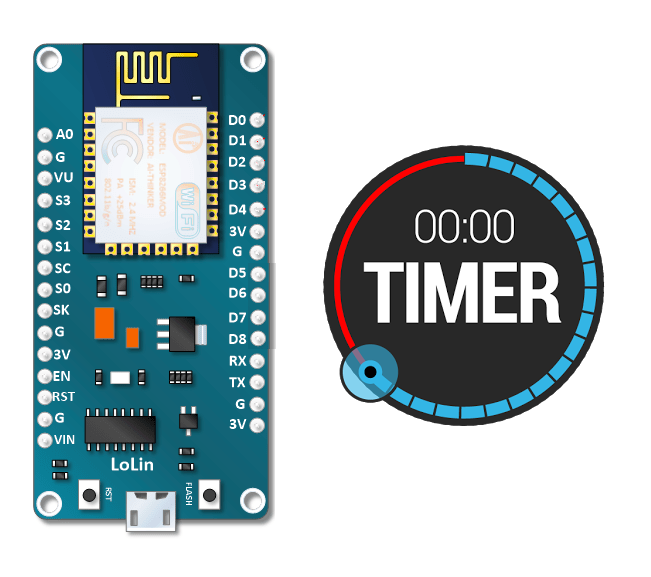

It is used by the Arduino tone() function.

Timer2 is an 8-bit timer that is very similar to Timer0. The Arduino Servo library uses this timer, so keep that in mind if you use this timer in your projects. Timer1 is a 16-bit timer, with a maximum counter value of 65535 (an unsigned 16-bit integer). Timer0 is used by native Arduino timing functions such as delay() and millis(), so unless you know what you are doing, timer 0 is best left alone. Timer0 is an 8-bit timer, meaning its counter register can record a maximum value of 255 (the same as an unsigned 8-bit byte).
#Esp8266 timer example software
They also have a watchdog timer, which can be used as a safeguard or a software reset mechanism. The ATmega8, ATmega168 and ATmega328 have three timers: Timer0, Timer1, and Timer2. In the standard Arduino variants or the 8-bit AVR chips, there are several timers at your disposal. The 16 MHz crystal that is usually part of a setup for an Atmega328 can be considered as part of the internal clock. You can supply an external clock source for use with timers, but usually the chip’s internal clock is used as the clock source. The timer resolution thus is 0.0625 millionth of a second.įor 8 MHz this would be 0.125 millionth of a secondĪnd for 1 MHz exactly one millionth of a second If you provide a 16 MHz clock signal to a timer, the timer resolution (or timer period) is: T = 1 / f (f is the clock frequency) Since timers are dependent on the clock source, the smallest measurable unit of time will be the period of the clock. Every time the timer detects this signal, it increases its counter by one. To increment the counter value at regular intervals, the timer must have a clock source. The ISR will automatically reset the overflow flag, so using interrupts is usually your best option for simplicity and speed.
#Esp8266 timer example code
And as with any other interrupt, you can specify an Interrupt Service Routine (ISR) to run your own code when the timer overflows. This flag can be checked manually, or you can have the timer trigger an interrupt as soon as the flag is set.

The timer normally sets a flag bit to let you know an overflow has occurred. The timer increments this counter one step at a time until it reaches its maximum value, at which point the counter overflows, and resets back to zero. The counter register can count to a certain value, depending on its size (usually 8 bits or 16 bits). Timers work by incrementing a counter variable known as a counter register. The LED will blink perfectly on time, regardless of what your main program was just doing How do timers work?

With a timer interrupt, you can set up the interrupt, then turn on the timer. If you are not using timers but just conventional code techniques, you’d have to set a variable with the next time the LED should blink, then check constantly to see if that time had arrived. So suppose you have a device that needs to do something –like blink an LED every 5 seconds. Rather than running a loop or repeatedly calling millis(), you can let a timer do that work for you while your code does other things. Timers, like external interrupts, run independently from your main program. When that point arrives, that alert interrupts the microprocessor, reminding it to do something, like run a specific piece of code. Like in real life, in microcontrollers a timer is something you set to trigger an alert at a certain point in the future.
#Esp8266 timer example how to
This article will discuss AVR and Arduino timers and how to use them in Arduino projects or custom AVR circuits.


 0 kommentar(er)
0 kommentar(er)
